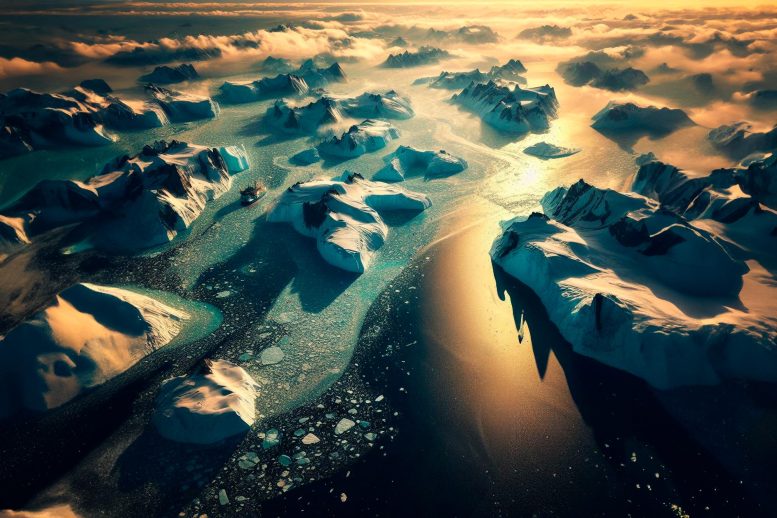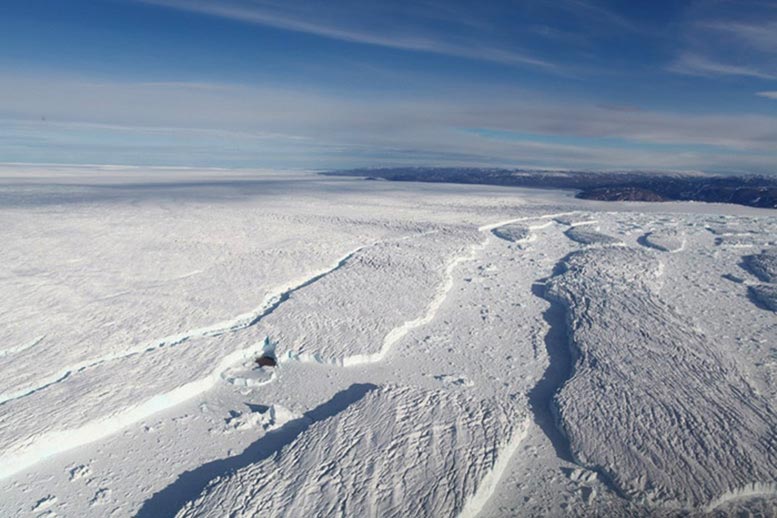
Researchers reveal that North Greenland’s ice shelves have lost over one-third of their volume since 1978, mainly due to rising ocean temperatures. This loss threatens their role as natural barriers against ice discharge into the ocean, potentially accelerating sea level rise.
A new study shows the largest floating ice shelves in North Greenland have lost more than a third of their volume since 1978, largely due to warming ocean temperatures. This melting poses a risk to their crucial role in limiting ice flow into the ocean, impacting sea level rise.
The largest floating ice shelves in the polar ice sheet have lost more than a third of their volume since 1978. In a study published on November 7 in the journal Nature Communications, scientists from the CNRS,[1] alongside their Danish and American colleagues, have established that most of this thinning is due to the rise in surrounding ocean temperatures, which causes the glaciers’ floating extensions to melt. Until now, the glaciers in this region were considered to be stable, unlike more sensitive areas of the polar ice cap, which began to weaken in the mid-1980s.

The Zachariæ Isstrøm glacier in 2016, discharging several kilometer-long icebergs into the ocean. The melting of platforms in North Greenland could make a significant contribution to rising sea levels. Credit: © Romain Millan
Located in North Greenland, these ice shelves play an essential role in regulating the amount of ice discharged into the ocean by acting as huge frozen “dams.” Although Greenland is already responsible for 17% of the current rise in sea levels, any weakening of these barriers could lead to an increase in the amount of ice released, accelerating further rises in the water level.
These results were obtained using field observations, aerial photography, and satellite data, combined with regional climate models.
Notes
- Working at the Institut des géosciences de l’environnement (CNRS/Université Grenoble Alpes/IRD/Inrae/Grenoble INP).
Reference: “Rapid disintegration and weakening of ice shelves in North Greenland” by R. Millan, E. Jager, J. Mouginot, M. H. Wood, S. H. Larsen, P. Mathiot, N. C. Jourdain and A. Bjørk, 7 November 2023, Nature Communications.
DOI: 10.1038/s41467-023-42198-2









“The eight ice shelves that are surveyed are the floating extensions of the following glaciers : …”
If the ice shelves are floating, then they have already contributed as much to sea level rise as they are capable of! That is, floating ice displaces a volume of water equal to the mass of the floating ice. Melting the base of the ice shelf will NOT cause sea level to rise!
“…, these ice shelves play an essential role in regulating the amount of ice discharged into the ocean by acting as huge frozen ‘dams.'”
The floating ice still has the same velocity as the ice on land. If it had sped up, it would have developed tension cracks as it outraced the ice up slope; if it had slowed down, it would have developed compressional features such as pressure ridges or stacked layers. One does not see the latter, suggesting that the so-called buttressing effect from floating ice is negligible, and the speed is limited primarily by the upstream basal friction with bedrock, or the resistance to shearing over an irregular topography. Floating ice might encounter a ridge or former terminal moraine, and experience resistance at that point, as evidenced by compressional features. However, that doesn’t seem to be the case.
One frequently sees reference to the so-called buttressing effect of shelf ice, but I have seen little in the literature to support the claim.
One might ask if the warming water is contributing to local thermosteric increase in water volume, and hence apparent rise in sea level. Even if the shelf ice were not melting, the addition of more glacier ice every year would cause the sea level to rise — just like adding too much ice to one’s mixed drink AFTER it had been filled with liquid.
I have to congratulate the authors for providing margins of error for their measurements and calculations. However, I’m still dubious about the claims made.
“However, I’m still dubious about the claims made.”
As are most people who take the time to think for themselves and not rely on “studies” that achieve the results that are desired.